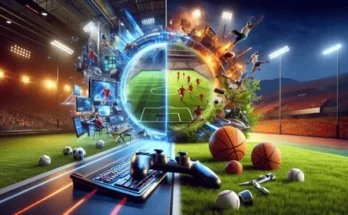A New Era of Gaming:
Games have always held a place in human culture. From ancient board games carved into stone to card games played around the family table, the essence of play has traveled through time with us. But today, games have transformed into something far more expansive and immersive than ever imagined.
We live in an era where games are not just about fun. They are powerful tools of expression, competition, learning, connection, and storytelling. With the rise of digital platforms, esports, mobile gaming, and virtual worlds, the gaming landscape has evolved into a multi billion dollar global industry that touches every generation and culture.
The Evolution of Games in the Modern World:
- From Consoles to the Cloud
Once limited to arcade cabinets and bulky consoles, games have now moved beyond physical space. Cloud gaming allows users to stream high definition games on demand without the need for expensive hardware. Services like Xbox Cloud Gaming and NVIDIA GeForce Now offer instant access to massive libraries, transforming how players engage with their favorite titles.
Mobile games have also exploded in popularity, offering quick and accessible entertainment to people across all age groups. Whether it is a puzzle game on a phone or an expansive role playing game on a console, the accessibility of gaming has never been greater.
- The Rise of Esports and Game Streaming
Competitive gaming has become a legitimate career path for many. Esports tournaments attract millions of viewers and offer prize pools that rival traditional sports. Games like League of Legends, Dota Two, and Valorant have built loyal fanbases and professional teams that compete internationally.
Streaming platforms such as Twitch and YouTube Gaming have given rise to a new kind of celebrity. Streamers and content creators build massive audiences by showcasing gameplay, offering tutorials, and engaging with fans in real time. Gaming has become not just a solo or multiplayer activity but also a performance art.
The Diversity of Games Today:
- Genres That Define the Industry
Today’s game market is a colorful spectrum of genres, each offering a unique kind of experience. Action games test reflexes and coordination. Strategy games challenge logic and foresight. Role playing games immerse players in rich storylines and fantastical worlds. Simulation games mimic real life, from farming to flying airplanes.
Horror games create tension and fear through immersive atmospheres. Puzzle games invite thoughtful problem solving. Casual games provide lighthearted fun for short bursts of time. And then there are sandbox games, where players are free to create and explore without rigid rules.
This incredible variety means that games are not just for children or hardcore fans. There is truly something for everyone.
- Storytelling Through Interactivity
Games have also become powerful storytelling tools. Unlike passive media such as films or books, games let players shape the narrative. Titles like The Last of Us, Red Dead Redemption Two, and Life is Strange have elevated storytelling in games to emotional and cinematic levels.
Players make decisions that affect outcomes. They become invested in characters they help shape. They explore themes of morality, identity, love, loss, and survival in ways that traditional media cannot fully replicate. Games have proven they can be both art and experience.
The Pros of Modern Gaming:
- Cognitive and Emotional Benefits
Contrary to outdated stereotypes, playing games can offer numerous cognitive benefits. Strategic thinking, hand eye coordination, problem solving, and spatial awareness are often sharpened through gameplay. Certain games even improve language and memory skills.
Games can also provide emotional relief. For many, games are a way to unwind after a stressful day. They offer safe environments to express emotions, explore identities, and experience challenges without real world consequences.
In educational settings, gamification is being used to make learning more engaging. Students learn history through historical simulation games or math through logic puzzles disguised as fun.
- Building Communities and Friendships
One of the most beautiful aspects of gaming is the ability to connect with others. Online multiplayer games like Fortnite, Minecraft, and Among Us have brought friends together even during physical separation.
Gaming community from across the globe. People forge real friendships, collaborate on creative projects, or support each other through personal challenges. Whether it is a guild in an MMORPG or a local LAN party, games often create bonds that transcend the screen.
The Cons and Concerns of Modern Games:
- Screen Time and Physical Health
As with any form of entertainment, moderation is key. Excessive screen time from gaming can lead to sedentary lifestyles, poor posture, disrupted sleep, and eye strain. For younger audiences, it can impact development and physical activity levels.
While games can be educational and enriching, spending too much time in virtual worlds can result in disconnection from real world responsibilities and relationships. Balance is essential to enjoy the benefits without falling into unhealthy habits.
- Addiction and Behavioral Challenges
Gaming addiction has become a recognized issue. For some individuals, especially younger players, the dopamine rush of winning or leveling up can lead to compulsive play. This can interfere with academic performance, work obligations, and mental well being.
Certain game designs, particularly those using loot boxes or microtransactions, have been criticized for promoting gambling like behavior. This raises ethical questions about targeting vulnerable players and encouraging spending under the guise of fun.
- Toxicity in Online Spaces
While online gaming communities can be supportive and inclusive, they are not without their darker sides. Toxic behavior including harassment, discrimination, and bullying is a well documented problem in some gaming circles.
Developers and platforms are taking steps to moderate chats, ban offensive players, and promote respectful conduct. But there is still progress to be made in making all game environments welcoming and safe for every type of player.
Current Trends Shaping the Gaming Industry:
- Inclusivity and Representation
The industry is becoming more conscious of diversity and representation. More games now feature protagonists from various cultures, genders, and backgrounds. Players are demanding authentic stories and characters they can identify with.
Games such as Celeste and Spiritfarer have tackled themes of mental health, grief, and self discovery in sensitive and meaningful ways. Indie developers especially are pushing boundaries by telling stories that mainstream studios often overlook.
- Virtual Reality and Immersive Technology
Virtual Reality has taken immersion to a new level. Games like Half Life Alyx and Beat Saber show how physical interaction can create unforgettable gaming experiences. While still developing, VR promises a future where gaming blends seamlessly with our senses and surroundings.
Augmented Reality and Mixed Reality are also being explored, where virtual elements are layered over the real world. These technologies are opening the door for new forms of play, education, and interaction.
The Future of Gaming A Digital Frontier:
The future of games will be shaped by creativity, technology, and community. As artificial intelligence evolves, we may see more adaptive games that learn from player behavior. Storylines could change based on emotional cues or choices made over months of gameplay.
Cross platform play will continue to connect players across devices. Subscription based services may become the norm, offering access to hundreds of titles for a monthly fee. And with blockchain and decentralization, we may even see player owned economies within games.
What remains certain is that games will keep evolving and touching every aspect of life from entertainment to education, from therapy to art.
Conclusion:
Modern games are more than escapism. They are worlds of imagination, tests of skill, windows into other lives, and bridges between people. They come with challenges but also enormous potential for personal and societal growth.
To engage with games today is to step into a universe of possibility. Whether you are a casual player or a lifelong gamer, the key is balance. Celebrate the joy of play, learn from it, share it, and remember that the controller is in your hands. The game is only as meaningful as the way you choose to play it.




